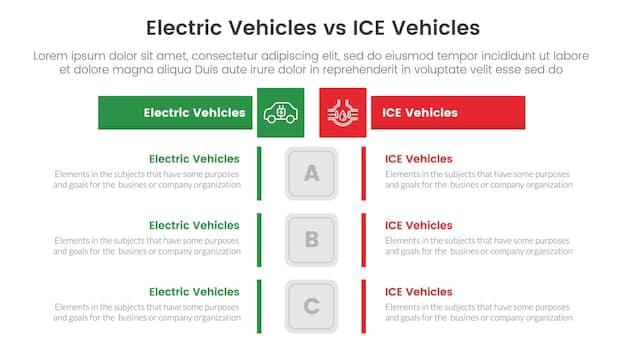Electric Vehicle Maintenance Costs: 5-Year Savings Analysis

Electric vehicle (EV) maintenance costs are significantly lower than those of gasoline vehicles, offering potential savings over a 5-year period due to fewer moving parts, reduced need for oil changes, and less frequent brake service.
Switching to an electric vehicle can lead to substantial savings, but how much can you really save on maintenance over the first five years? This article dives into electric vehicle maintenance costs: data-driven insights on savings compared to gas vehicles over 5 years, providing a clear picture of the financial benefits of going electric.
Understanding the Basics of EV Maintenance
Electric vehicles are gaining popularity, and for good reason. Beyond environmental benefits, they often offer lower running costs. Understanding the basics of EV maintenance can help you appreciate the potential savings compared to traditional gasoline cars.
Simplified Mechanics in EVs
One of the primary reasons EVs have lower maintenance costs is their simplified mechanics. Electric vehicles have significantly fewer moving parts than gasoline cars, reducing the potential for breakdowns and the need for frequent repairs.
Regenerative Braking and Reduced Wear
Another key factor is regenerative braking, a feature in EVs that uses the motor to slow down the vehicle, converting kinetic energy back into electricity. This reduces the wear on brake pads and rotors, extending their lifespan considerably.
- Fewer fluid changes (no oil changes)
- Reduced brake wear due to regenerative braking
- Less frequent maintenance checks overall
These factors combine to make EV maintenance simpler and less costly than maintaining a gasoline-powered vehicle.
Comparing Maintenance Schedules: EV vs. Gas
When comparing maintenance schedules between electric and gas vehicles, the differences are stark. Gas vehicles require regular oil changes, tune-ups, and other services that EVs largely avoid.

Typical Maintenance for Gasoline Vehicles
Gasoline vehicles typically need oil changes every 3,000 to 7,500 miles, depending on the vehicle and the type of oil used. They also require regular filter replacements, spark plug changes, and timing belt replacements, adding up over time.
Minimal Maintenance for Electric Vehicles
Electric vehicles, on the other hand, have minimal maintenance needs. The primary tasks include tire rotations, windshield wiper replacements, and occasional checks of coolant levels and brake fluid. There are no spark plugs, timing belts, or oil to change.
- EVs don’t need oil changes
- EVs require less frequent brake service
- EVs only need occasional coolant and fluid checks
By understanding these differences, it’s easier to see where the cost savings come from when owning an EV.
Data Analysis: Maintenance Costs Over 5 Years
To understand the real cost savings, it’s essential to look at the data. Various studies and reports analyze the maintenance costs of EVs compared to gas vehicles over a five-year period. These analyses often reveal significant differences in expenditure.
Research and Reports on EV Maintenance
Several organizations have conducted research on the total cost of ownership for EVs, including maintenance. These reports consistently show that EVs have lower maintenance costs than comparable gas vehicles.
Factors Influencing Maintenance Cost
Several factors influence maintenance costs, including the vehicle’s make and model, driving habits, and local labor rates. However, even when accounting for these variables, EVs tend to come out ahead in terms of maintenance savings.

Analyzing the data helps to quantify the savings and provides a clearer picture of the long-term financial benefits.
Common EV Maintenance Tasks and Their Costs
While EVs require less maintenance overall, they still have some specific needs. Knowing the common EV maintenance tasks and their costs can help you budget effectively and anticipate potential expenses.
Tire Maintenance
Tire maintenance is crucial for EVs due to their instant torque, which can cause tires to wear more quickly. Regular tire rotations and maintaining proper inflation are essential.
Battery Health and Maintenance
The battery is the most critical component of an EV, and while it generally requires little maintenance, monitoring its health is important. Over time, batteries may degrade, affecting range and performance.
- Tire rotations every 6,000 to 8,000 miles
- Regular inspection of brake pads and rotors
- Coolant checks and top-ups as needed
Understanding these tasks helps to keep your EV running smoothly and efficiently.
Long-Term Savings: Beyond the First 5 Years
The benefits of lower maintenance costs extend beyond the first five years of ownership. As gas vehicles age, they often require more frequent and costly repairs. EVs, with their simpler mechanics, tend to remain more reliable over the long term.
Reduced Risk of Major Repairs
EVs have fewer parts that can break down, reducing the risk of major repairs such as engine or transmission replacements. This leads to greater long-term savings compared to gasoline cars.
Extending Battery Life
Proper charging habits and battery care can significantly extend the life of an EV battery. Keeping the battery within the recommended charge range (20-80%) can help prevent degradation and maintain optimal performance.
The long-term savings make EVs an attractive option for those looking to reduce their overall cost of ownership.
Maximizing Your EV Maintenance Savings
To maximize your EV maintenance savings, it’s important to adopt good driving habits and follow the manufacturer’s recommendations. Proper care and attention can further reduce your maintenance costs and extend the life of your vehicle.
Driving Habits and Efficiency
Smooth acceleration and gentle braking can reduce wear on tires and brakes, further extending their lifespan. Avoiding aggressive driving habits can lead to significant savings over time.
Following Manufacturer Guidelines
Adhering to the manufacturer’s recommended maintenance schedule ensures that your EV receives the necessary care at the right intervals. This can help prevent minor issues from becoming major problems.
- Drive smoothly to reduce tire and brake wear
- Keep your EV clean to prevent corrosion
- Monitor battery health and charging habits
By following these tips, you can maximize your EV maintenance savings and enjoy the full benefits of electric vehicle ownership.
| Key Point | Brief Description |
|---|---|
| 💡 Fewer Moving Parts | EVs have fewer parts, reducing breakdowns and maintenance needs. |
| ♻️ Regenerative Braking | Regenerative braking reduces brake wear and extends brake pad life. |
| 🚫 No Oil Changes | EVs don’t require oil changes, saving you time and money. |
| 🔋 Battery Health | Monitor battery health for optimal performance and longevity. |
Frequently Asked Questions
▼
Yes, electric vehicles are generally cheaper to maintain due to fewer moving parts and the absence of oil changes, leading to reduced service requirements and lower costs.
▼
The main maintenance tasks for EVs include tire rotations, brake inspections, windshield wiper replacements, and occasional coolant and brake fluid checks.
▼
EV batteries typically last for 100,000 to 200,000 miles before significant degradation occurs, and replacement might not be needed for many years.
▼
Yes, regenerative braking significantly reduces wear on brake pads and rotors, extending their lifespan and reducing the frequency of brake service.
▼
To maximize battery life, avoid fully charging or depleting the battery, and try to keep the charge level between 20% and 80% whenever possible.
Conclusion
In conclusion, the data clearly shows that electric vehicles offer significant maintenance savings compared to gasoline cars over a five-year period. With fewer moving parts, regenerative braking, and the elimination of oil changes, EVs provide a cost-effective and environmentally friendly transportation option.





